In short
The Tamron Di II SP 17-50mm F / 2.8 VC is a balanced fast universal zoom lens for cropped cameras. An alternative for more expensive Nikon DX AF-S Nikkor 17-55mm 1: 2.8G ED IF SWM и Canon Zoom Lens EF-S 17-55mm 1: 2.8 IS USM.
Tamron Di II SP 17-50mm F / 2.8 VC is a significant upgrade to an older version Tamron 17-50mm F / 2.8 XR Di II LD Aspherical (IF). The main innovation is the availability of the image stabilizer Tamron VC.
Tamron Di II SP 17-50mm F / 2.8 VC is available only for Nikon (model B005 N II) and Canon (model B005 E) cameras.
In general, the Tamron Di II SP 17-50mm F / 2.8 VC is on par with a similar third-party lens - Sigma DC 17-50mm 1: 2.8 Zoom EX OS HSM,
The Tamron Di II SP 17-50mm F / 2.8 VC has been in my personal use for a long time as a 'workhorse' for crop cameras and left a good impression.
Key Features of Tamron Di II SP 17-50mm F / 2.8 VC:
| Review Instance Name | The lens barrel says 'Ø 72 Di II Tamron SP 17-50mm F / 2.8 B005 Made in Japan 110612' |
| Basic properties |
|
| Front Filter Diameter | 72 mm |
| Focal length | 17-50 mm EGF for Nikon DX cameras is 25.5-75 mm |
| Zoom ratio | 2.94 X (often rounded to three) |
| Designed by | for Nikon DX cropped digital cameras |
| Number of aperture blades | 7 rounded petals that form a fairly even hole |
| Tags | focusing distance in meters and feet, focal lengths for 17, 24, 35, 50 mm, hood attachment mark, bayonet mount mark |
| Diaphragm | from f / 2.8 over the entire range of focal lengths to f / 32. The lens does not have an aperture ring (G - lens type for Nikon cameras) |
| MDF | 0.29 m, maximum magnification ratio 1: 4.8 (at a value of 50 mm focal length) |
| The weight | 570 g |
| Optical design | 19 elements in 14 groups of which:
Clickable Image |
| Lens hood | Supplied petal hood, AB003 |
| Manufacturer country | MADE IN JAPAN (but there are lenses made in China) |
| Price | |
| Period | From September 17, 2009 to the present day |
Assembly
Tamron Di II SP 17-50mm F / 2.8 VC is made only in Japan. To the touch the lens is pleasant, strong, weighty. The retractable frame of the body ('trunk') consists of one section, which is strong enough, without any backlash. To the touch Tamron Di II SP 17-50mm F / 2.8 VC is much better than its previous model Tamron 17-50mm F / 2.8 XR Di II LD Aspherical (IF).
The lens has metal bayonet mount. The zoom and focus rings are rubberized. Changing the focal length runs smoothly. The zoom ring can rotate quite tight for the first time.
There is a bayonet mount mark and a mark on the case for quick installation of the hood. The lens uses a plastic hood, which is fixed in special grooves located near the front lens of the lens. The hood can be installed in the opposite direction for transportation. In this position, access to the focus ring at 17 mm focal length is lost. When you change the focal length, the lens hood moves with the front of the lens.
When changing the focal length, the rear lens moves in the middle of the lens body like a pump - it draws in and pushes out air. This behavior of the rear lens is called 'vacuum cleaner effect', which can increase the amount of dust that accumulates in the camera.
The number of diaphragm blades is 7 pieces. At the same time, they are slightly rounded and already form a heptagon on strongly covered diaphragms.
For Tamron Di II SP 17-50mm F / 2.8 VC, the direction of rotation of the zoom and focus rings coincides with the direction of the original Nikon DX AF-S Nikkor 17-55mm 1: 2.8G ED IF SWM.
It is believed to be a lens from the Tamron SP professional line. Many professional lenses use the classic 77 mm filters, 72 and 82 mm - less often. The Tamron Di II SP 17-50mm F / 2.8 VC has 72mm filters.
Despite the good build of the Tamron Di II SP 17-50mm F / 2.8 VC, the overall reliability of the lens is very much inferior to the original metal super-lens Nikon 17-55 / 2.8G.
Repair masters claim that the internal implementation of the lens assemblies is not very good. Personally, I was faced with the fact that with a light blow, the section on which the focus and stabilizer switches are mounted broke completely. This section is made of very thin prastik.
Lock 'LOCK ′
Frame (trunk) at Tamron Di II SP 17-50mm F / 2.8 VC does not spontaneously change its size under its own weight (perhaps this can only begin with time). To prevent future inconveniences, a focal length switch 'LOCK' (the so-called 'lock') is present on the lens body, which tightly locks focal length at a value of 17 mm.
To fix the trunk of the lens, you must first set the 17 mm focal length. Near the button there is a drawn arrow that indicates in which direction the switch should be moved to lock the lens.
The switch is located in a convenient place - under the thumb of the left hand, so the lens can be quickly and comfortably 'removed from the lock' before starting shooting.
The effect of spontaneous changes in focal length (trunk creep) in this lens is quite noticeable.
Focusing
For focusing, the lens uses a micro motor that is noisy. Tamron Di II SP 17-50mm F / 2.8 VC will automatically focus on all Nikon DX cameras.
When used on a camera Nikon D40, D80, D200, Nikon D90 with unpretentious focusing systems the lens behaved well. I had no particular problems with focusing accuracy and tenacity. The lens clings well to the subjects being shot, rarely refocuses. The number of focusing misses is minimal.
Auto focus speed average, comfortable for the vast majority of photo tasks. Focusing speed is significantly lower than the original Nikon DX AF-S Nikkor 17-55mm 1: 2.8G ED IF SWM. Let me remind you that Nikon 17-55 / 2.8G so far it is the fastest original lens in the Nikon DX series (it uses a large and powerful ring SWM motor).
The focusing speed of the Tamron Di II SP 17-50mm F / 2.8 VC is identical to the older version with the focusing motor (Tamron 17-50mm F / 2.8 XR Di II LD Aspherical (IF) A16 NII)
Focus on Tamron Di II SP 17-50mm F / 2.8 VC internal - when focusing, neither the front nor the rear lens rotates, and the lens itself does not change its size when focusing. Sorry, but during auto focus focus ring rotates and cannot be touched. In such Nikon lenses, the focus ring remains stationary during auto focus.
In manual focus mode, the focus ring rotates approximately 60 degrees. Manual focus is quite inconvenient. When extreme positions are reached, the focus ring abuts and cannot be rotated further.
With manual focus, if the focus ring is tightly clasped, the focus ring starts to jerk. To manually shift the focus ring, you have to make a considerable effort, after which the ring begins to move and flies over the desired value.
The minimum focusing distance is only 29 cm (the distance from the camera’s matrix to the subject). With such an MDF, the maximum magnification ratio is 1: 4.8.
The lens has focus mode switch 'AF / MF'. For manual focus, the lens must be switched to 'M' mode, otherwise the focus motor may be damaged. Unfortunately, unlike many Nikon lenses of this type, Tamron Di II SP 17-50mm F / 2.8 VC does not support continuous manual focus mode.
Focus Features:
- There is a strong effect of 'Focus Breathing' (changing the viewing angle during focusing). During focusing towards MDF, the viewing angle increases.
- When changing the focal length, focusing is a bit confused.
- Unknown compatibility with teleconverters.
- Tamron Di II SP 17-50mm F / 2.8 VC does not have hard stop (hard infinity mechanical stop) which allows you to accurately and quickly focus the lens at infinity under any external conditions.
- The lens has a focus distance scale with marks in meters and feet. The scale is plotted on the focus ring. The scale is very meager, on it there are marks for only 6 values of the focusing distance (including 'infinity'). More advanced lenses usually use a scale in the form of a special window.
- Focus shift (shift-focus) was not noticed.
- Tamron Di II SP 17-50mm F / 2.8 VC has no focus problems in Live View (tested on Nikon D90 ), but focuses slowly.
- The lens transmits the focus distance to the subject in the camera (analog Nikon D, Nikon G).
- Tamron Di II SP 17-50mm F / 2.8 VC is a third-party lens. It may happen that it will not work correctly with some Nikon cameras. Details on this issue are considered by me. here.
Stabilizer
Tamron Di II SP 17-50mm F / 2.8 VC can use the built-in image stabilizer.
There is a VC ON / OFF stabilizer operation switch on the lens. The stabilizer works with noticeable noise.
The manufacturer does not indicate the effectiveness of the stabilizer. In practice, Tamron Di II SP 17-50mm F / 2.8 VC holds 2-3 stops on shutter speedwhich is quite good. I was able to take pictures of stationary objects from hand to hand without any problems shutter speed 1/15 sec and 50 mm focal length.
Nowhere is it indicated whether the stabilizer can track the movement of the lens during panoramic shooting. Unlike the original Nikon DX AF-S Nikkor 16-85mm 1: 3.5-5.6G ED VR SWM IF Aspherical Tamron Di II SP 17-50mm F / 2.8 VC has no choice of Active / Normal stabilization modes or the like
Important: during stabilizer activation (pressing the autofocus and / or metering activation button exposure) and during its deactivation (a few seconds after inactivity), the image in the viewfinder twitches noticeably. If you take a picture at this moment, you can get a blurry frame. To avoid this, you need to wait a bit after activating or deactivating the stabilizer.
Important: during shooting with the built-in flash with the stabilizer on, after each shutter release, the stabilizer turns off and on. Most likely this is due to the power consumption for charging the built-in flash. There is no such problem with an external flash.
Image quality
The lens is sharp in the center even at F2.8 and at all focal lengths, but still, it is far from fixed lenses. When you close the aperture to F3.5, contrast increases markedly. Closing to F5.6 sharply increases sharpness. The lens is very sharp on the F11-F16 aperture. Color reproduction is normal, the lens even boasts a nice nice bokeh at 50mm and F2.8. HA visible only 17 mm. If you really need it, then at 50 mm F2.8 you can shoot portraits, but even Nikon 50mm F1.8D a portrait will do better. A serious drawback of the image quality of the lens is distortion, which almost disappears by 50 mm. The lens also has a strong vignette of 17 mm (in the vicinity of the step at the edges of the frame) and a little smaller by 50 mm.
Sample Photos
The lens below is shown under real-world camera shooting conditions. Nikon D90:
You can take a look at a lot of photos from real shootings. here, here, here и here.
Personal impressions
The Tamron Di II SP 17-50mm F / 2.8 VC is a usable lens. But still Sigma DC 17-50mm 1: 2.8 Zoom EX OS HSM I like it more. There are several reasons: a quieter focusing motor of a different type, fewer problems with the focusing ring, and there is no jerking of the picture when the stabilizer is turned on. At the same time, for a long time I used Tamron Di II SP 17-50mm F / 2.8 VC for professional purposes and was completely satisfied with its optical performance and general capabilities.
Prices for the Tamron 17-50mm F / 2.8 XR Di II VC LD Aspherical (IF) lens in popular online stores can look at this linkor in the price block located below:
All Tamron 17-50 prices
Comments on this post do not require registration. Anyone can leave a comment. Many different photographic equipment can be found on AliExpress.
All fast universal zoom lenses
Below is a list of all such aperture-type universal zoom autofocus lenses for SLR and mirrorless cameras with an APS-C sensor or less.
Tokina (DX, various mounts)
- Tokina AT-X PRO SD 16-50 F2.8 DX Internal Focus, model AT-X 165 PRO DX, for Canon (C/EF version) and Nikon (N/AIS version), from July 2006. Optical design is the same as Pentax SMC DA* 16-50mm f/2.8 ED AL (IF) SDM
Tamron (DI II, DI III-A, various mounts)
- Tamron Aspherical LD XR DI II SP AF 17-50 mm 1: 2.8 [IF], model A16 N / E / P / S (under Nikon [N], Canon [E], Pentax [P], Sony / Minolta [S]), since February 2006. Produced in Japan, China and Vietnam
- promaster DIGITAL XR EDO AF Ashperical LD [IF] 17-50 mm 1: 2.8 MACROprevious lens under the brand Promaster
- Tamron Aspherical LD XR DI II SP AF 17-50 mm 1: 2.8 [IF], model A16 NII (only for Nikon cameras), since March 2008
- Tamron Di II SP 17-50 mm F / 2.8 VC B005, model B005 E / NII (for Canon [E] or Nikon [NII]), from September 2009, Japan or China)
- Tamron 17-70 mm F / 2.8 Di III-A VC RXD Model B070, Model B070, Sony E only, from December 2020
Sigma (DC, different mounts)
With constant maximum aperture (DC EX and DC ART series):
- Sigma DC ZOOM 18-50mm 1: 2.8 EX (+ -D), since July 2004, for Sigma SA, Nikon F, Canon EFS, Pentax K. The version for the '4/3' system has been available since February 2006 (not mass-produced). The version for Nikon in its name includes the prefix 'D'.
- Sigma dc 18-50mm 1: 2.8 EX MACRO, since September 2006, for Sigma SA, Nikon F, Canon EFS, Pentax K, 4/3
- Sigma dc 18-50mm 1: 2.8 EX MACRO HSM, since June 2007, for Nikon DX cameras only (Nikon F mount)
- Sigma dc 17-50mm 1: 2.8 ZOOM EXOS HSM, from February 2010, for Sigma SA, Nikon F, Canon EFS, Pentax K, Sony / Minotla A
- Sigma dc 18-35mm F1.8 A [ART, HSM], from April 2013, for Sigma SA, Nikon F, Canon EFS, Pentax K, Sony / Minotla A
- SIGMA DC 18-50 mm 1: 2.8 DN C [Contemporary], since Oct 2021, for Sony E, Leica L
With variable maximum aperture (DC and DC Contemporary series):
- Sigma dc 17-70mm 1:2.8-4.5, February 2006, for Sigma SA, Nikon F, Canon EFS, Pentax K, Sony / Minotla A
- Sigma dc 17-70mm 1:2.8-4.5 MACRO HSM, from July 2007, for Nikon DX cameras only (Nikon F mount)
- Sigma dc 17-70mm 1:2.8-4 MACRO HSM OS, from December 2009, for Sigma SA, Nikon F, Canon EFS, Pentax K, Sony / Minotla A
- Sigma dc 17-70mm 1:2.8-4 C, [MACRO, OS, HSM, Contemporary], from September 2012, for Sigma SA, Nikon F, Canon EFS, Pentax K, Sony / Minotla A
- Sigma dc 18-50mm 1:2.8-4.5 HSM OS ZOOM, from March 2009, for Sigma SA, Nikon F, Canon EFS, Pentax K, Sony / Minotla A
Nikon (DX, F mount)
- Nikon DX VR AF-S Nikkor 16-80mm 1:2.8-4E ED N, Nikon F mount, from July 2015
- Nikon DX AF-S Nikkor 17-55mm 1: 2.8G ED IF SWM, Nikon F mount, from July 2003
Pentax (DA, Q, K and Q mounts)
- Pentax SMC DA * 16-50 mm 1:2.8 ED AL (IF) SDM, Pentax KAF2 mount, since February 2007. Optical design is similar to the lens Tokina AT-X PRO SD 16-50 F2.8 DX Internal Focus (joint development of Tokina and Pentax)
- HD PENTAX-DA * 1: 2.8 16-50 mm ED PLMAW, from July 2021, Pentax KAF4 mount
- HD Pentax-DA 1: 2.8-4 20-40 mm ED Limited DC WR, Pentax KAF3 mount, black or silver body, from November 2013
- SMC Pentax 1: 2.8-4.5 5-15 mm ED AL [IF] [LENS 02], Pentax Q mount (crop factor Kf=5.53X or Kf=4.65X)
Canon (EFS, EF-S mount)
- Canon Zoom Lens EF-S 17-55mm 1: 2.8 IS USM (Image Sabilizer, Ulstrasonic, EFS), Canon EF-S mount, since May 2006
Sony (DT, A and E mounts)
- Sony DT 2.8/16-50 SSM, Sony A mount (Minolta A), since August 2011
- Sony E 2.8/16-55G (Sony SEL1655G), Sony E bayonet mount, from August 2019
Fujifilm(X)
- Fujinon Ashperical Lens Nano-GI XF 16-55mm 1: 2.8 R LM WR, Fujifilm X mount, since January 2015
- Fujinon Ashperical Lens Super EBC XF 18-55mm 1:2.8-4 RLM OIS, Fujifilm X mount, September 2012
Samsung (NX)
- Samsung lens 1: 2-2.8 S 16-50 mm ED OIS i-Function, Samsung NX mount, since January 2014
Olympus/Panasonic/Leica/Yongnuo (4/3, Micro 4/3, Kf=2X)
Mirrored 4/3:
- OLYMPUS ZUIKO Digital 11-22 mm 1:2.8-3.5, from February 2004
- OLYMPUS Digital 14-54 mm 1:2.8-3.5, from June 2003
- OLYMPUS Digital 14-54 mm 1:2.8-3.5 II, from November 2008
- OLYMPUS ZUIKO Digital 14-35 mm 1: 2 ED SWDsince January 2005
- Panasonic Lumix LEICA D VARIO-ELMARIT 1: 2.8-3.5 /14-50 ASPH. MEGA OIS, from July 2006
Mirrorless Micro 4/3:
- OLYMPUS M.ZUIKO DIGITAL 12-40 mm 1:2.8 PRO, since October 2013
- Panasonic Lumix Leica DG Vario-Summilux 10-25 mm f / 1.7 ASPH.since May 2019
- LUMIX G VARIO 1: 2.8 /12-35 ASPH. POWER OIS, since June 2012, in March 2017 an improved sub-version is released (outwardly they do not differ in any way)
- Panasonic Lumix Leica DG Vario-ELMARIT 1: 2.8-4.0 /12-60 ASPH., since March 2017
- Yongnuo 12-35 F2.8-4 STM ASPH, since April 2023
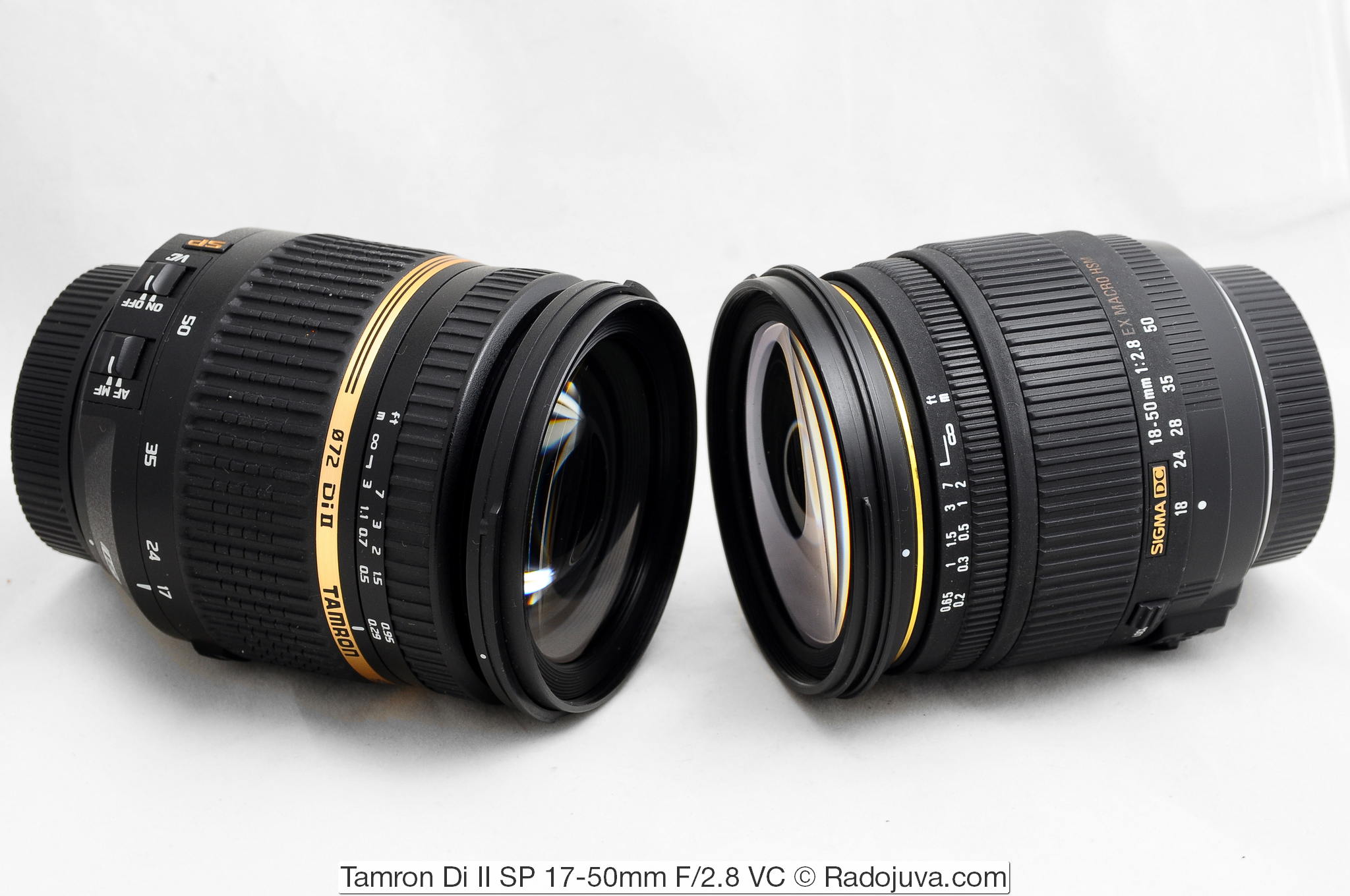
Tamron Di II SP 17-50mm F / 2.8 VC and Sigma DC 18-50mm 1: 2.8 EX MACRO HSM
Conclusions
Tamron Di II SP 17-50mm F / 2.8 VC - balanced versatile fast lens with convenient focal lengths for DX cameras and an image stabilizer. Suitable as a good staffer for DX cameras.
Material prepared Arkady Shapoval. Training/Consultations | Youtube | Facebook | Instagram | Twitter | Telegram

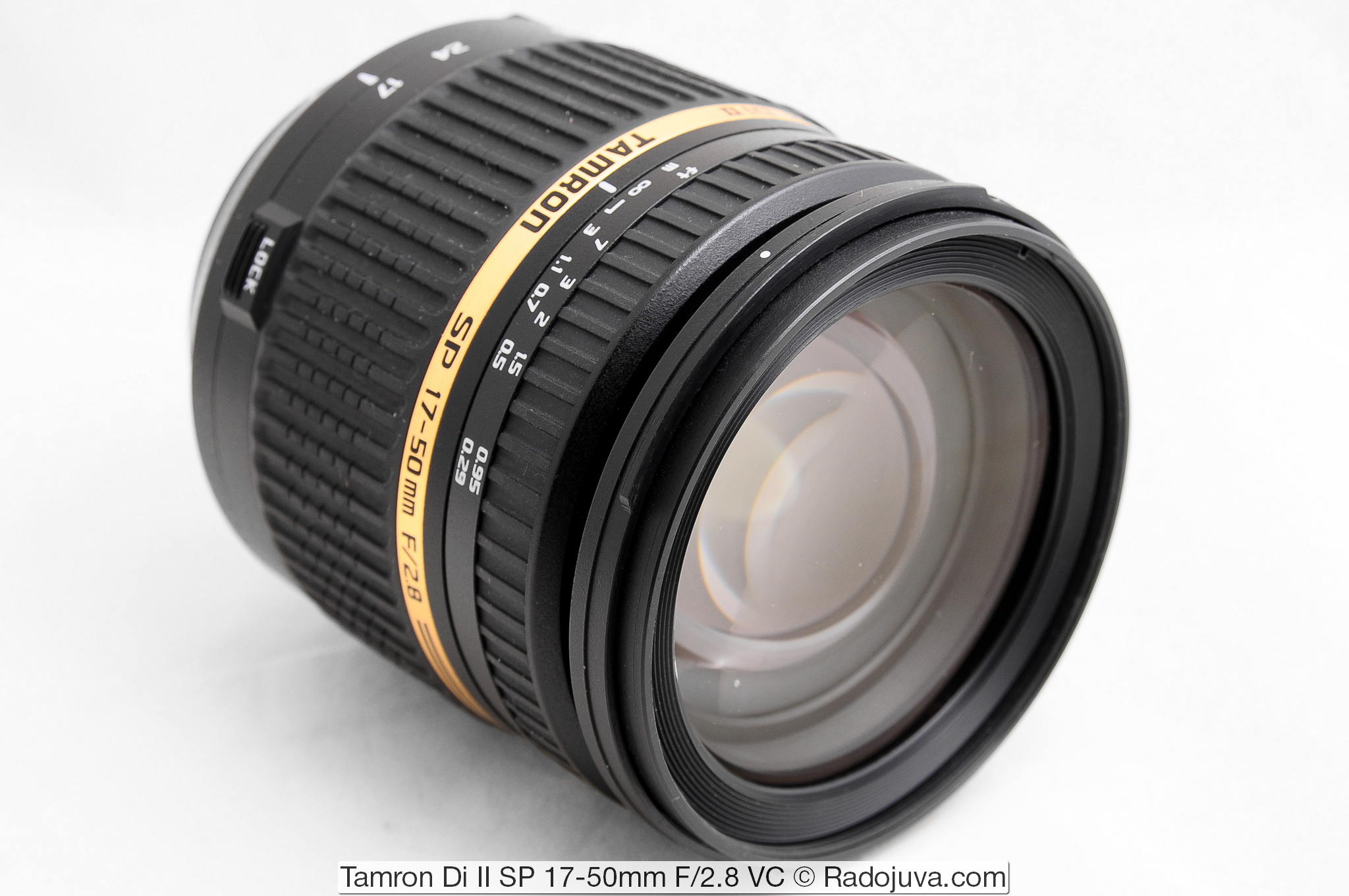
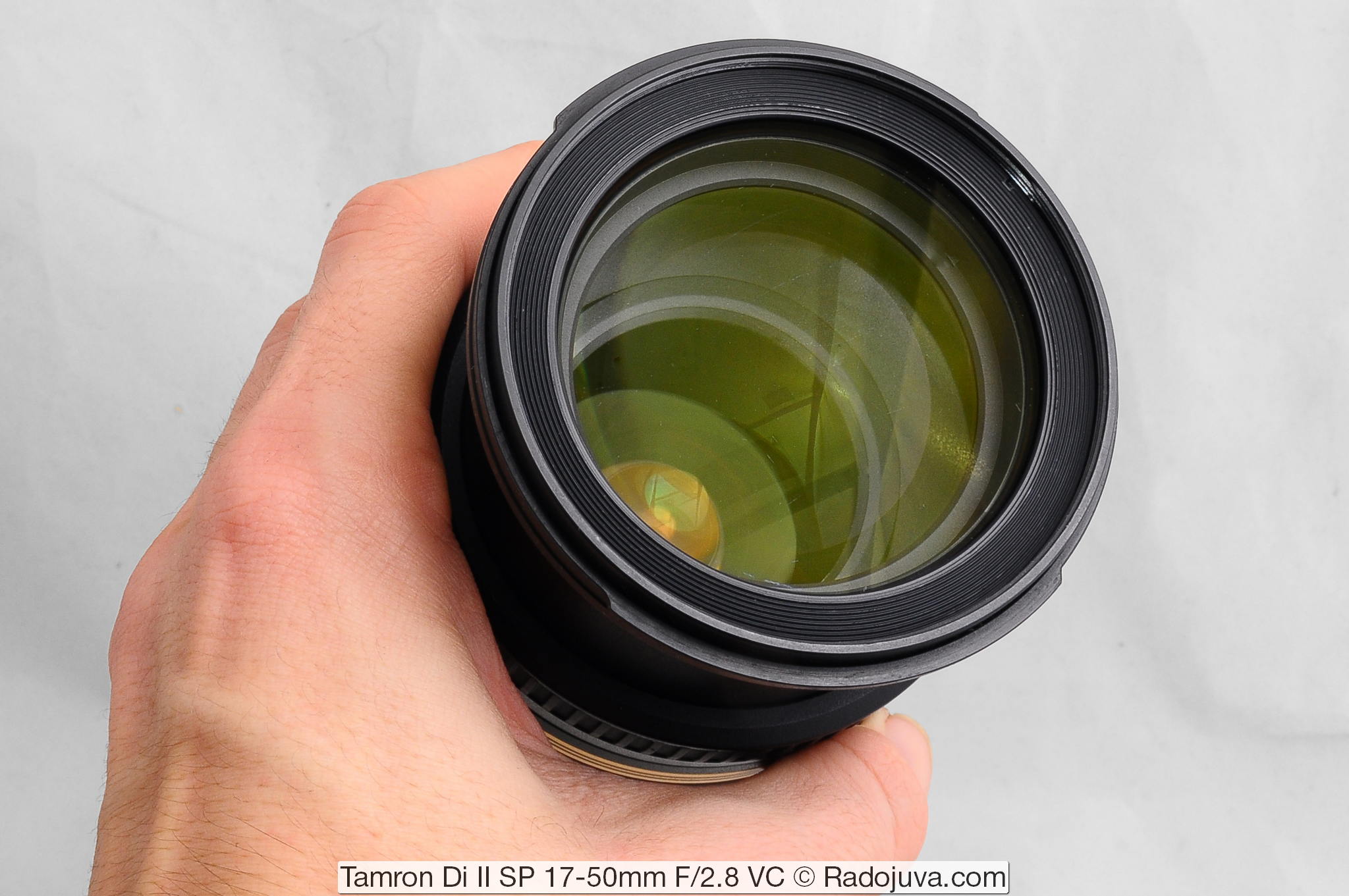
![Optical design SP AF 17-50mm F / 2.8 XR Di II VC LD Aspherical [IF]](https://radojuva.com/wp-content/uploads/2018/02/tamron-17-50-vc-optical-scheme-big-300x263.jpg)
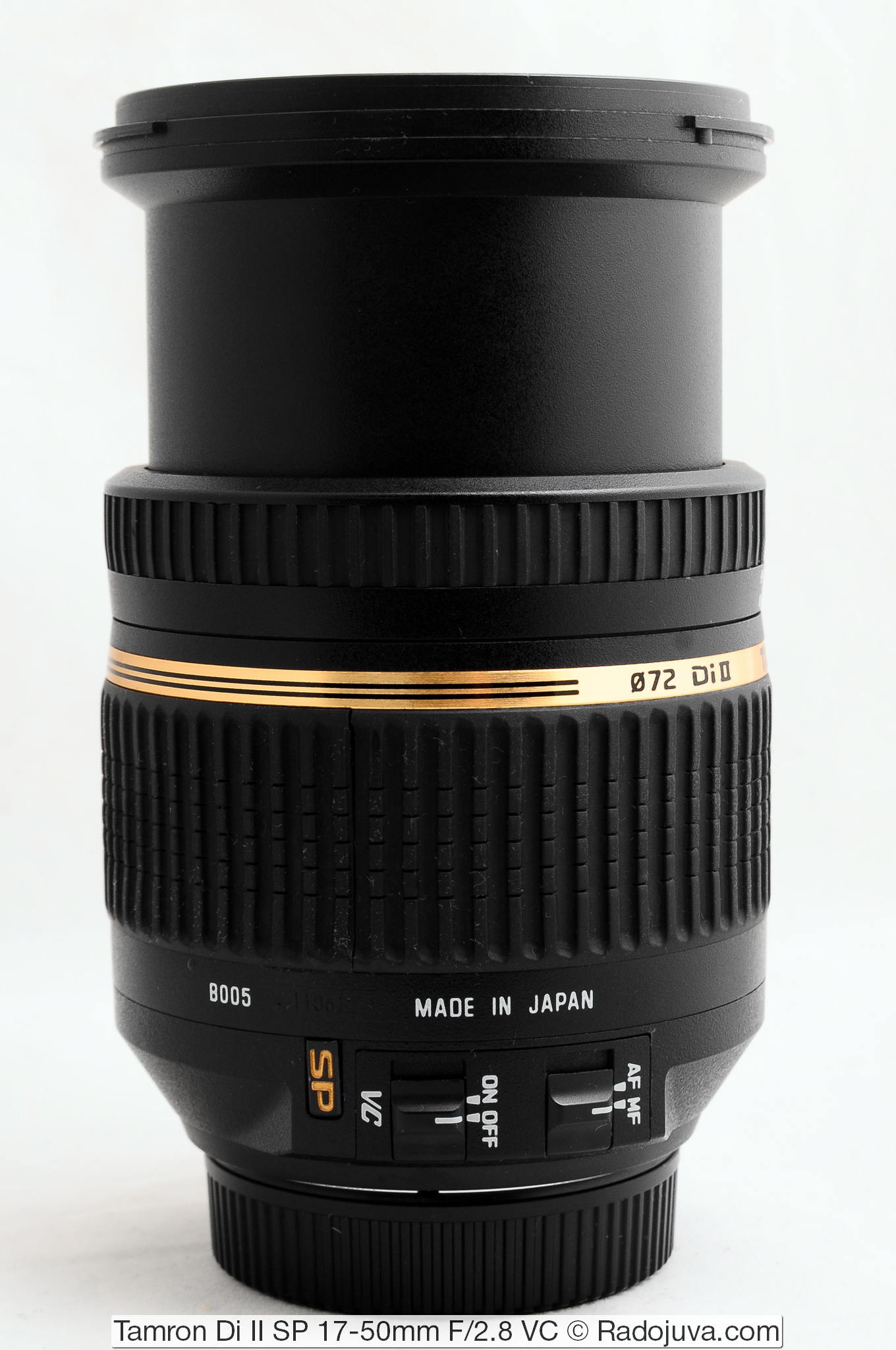

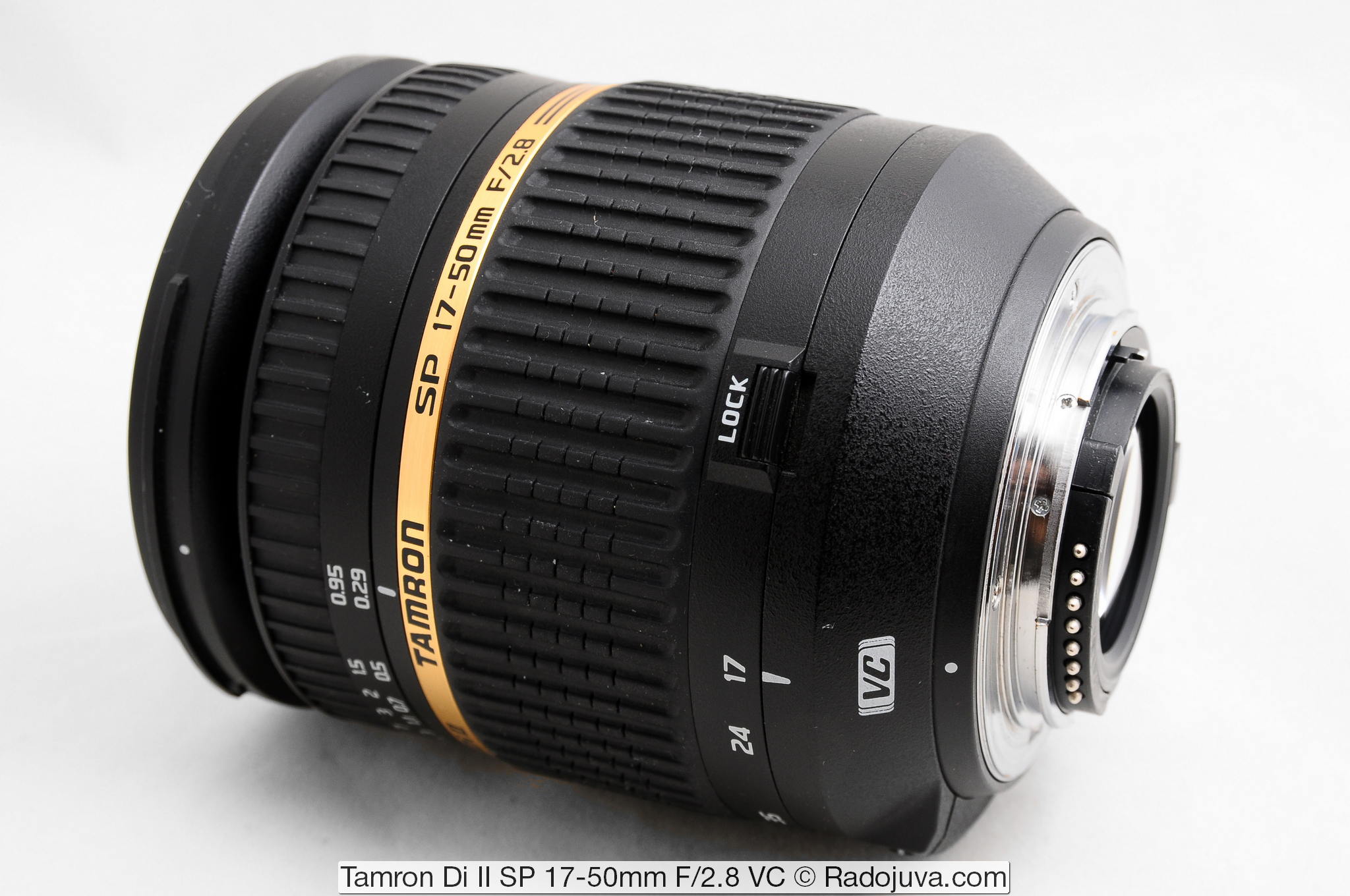
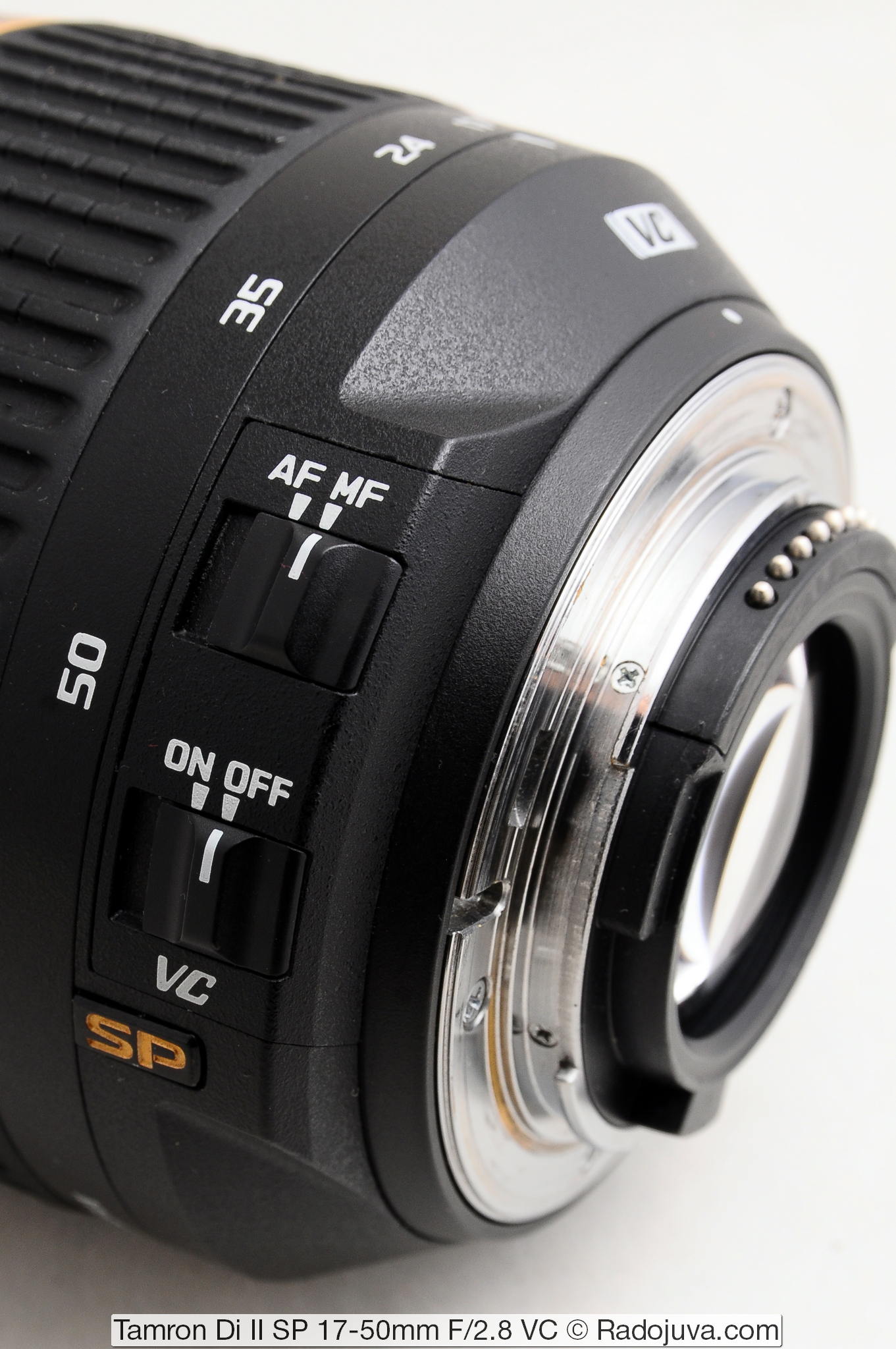
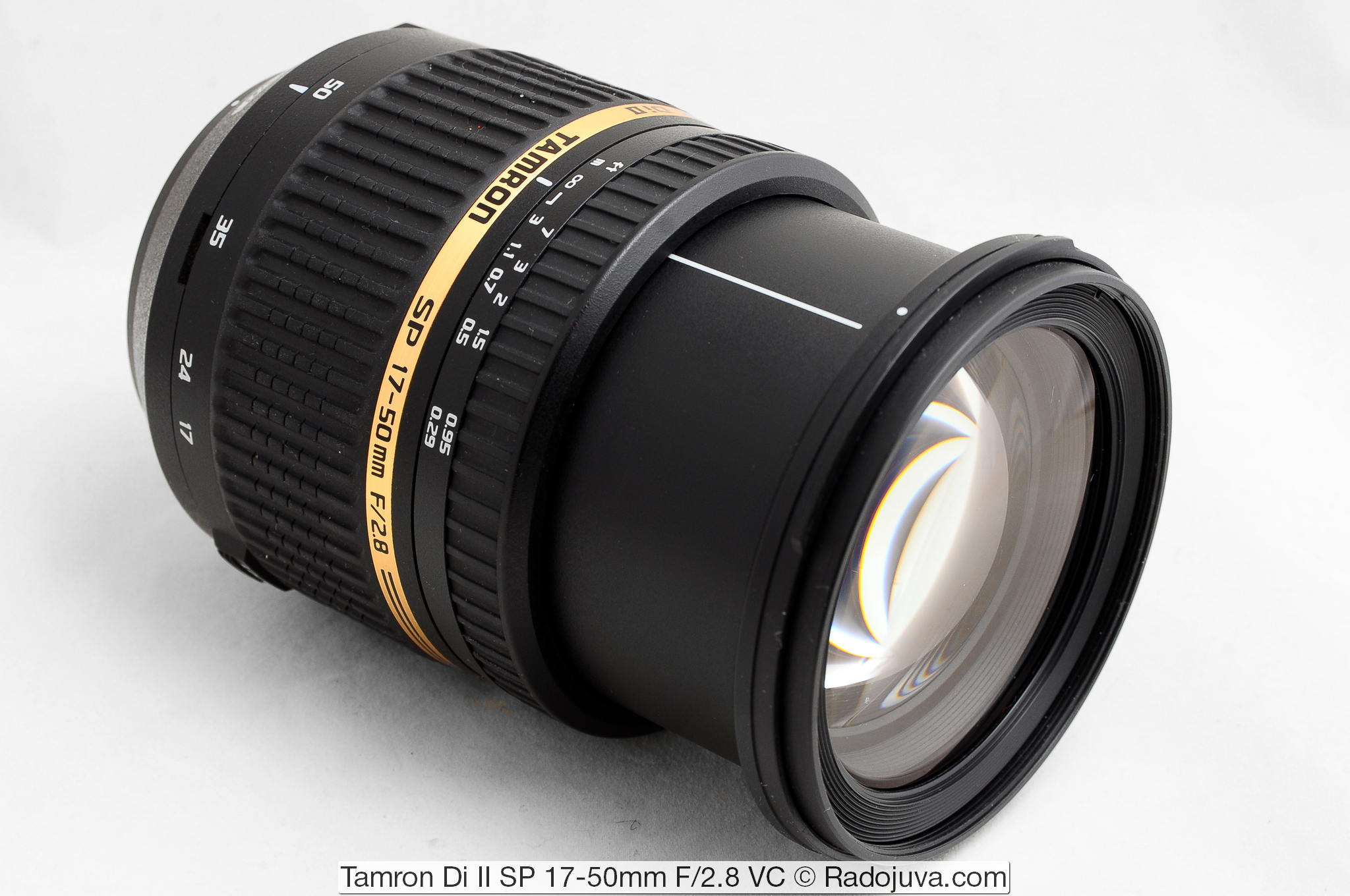






























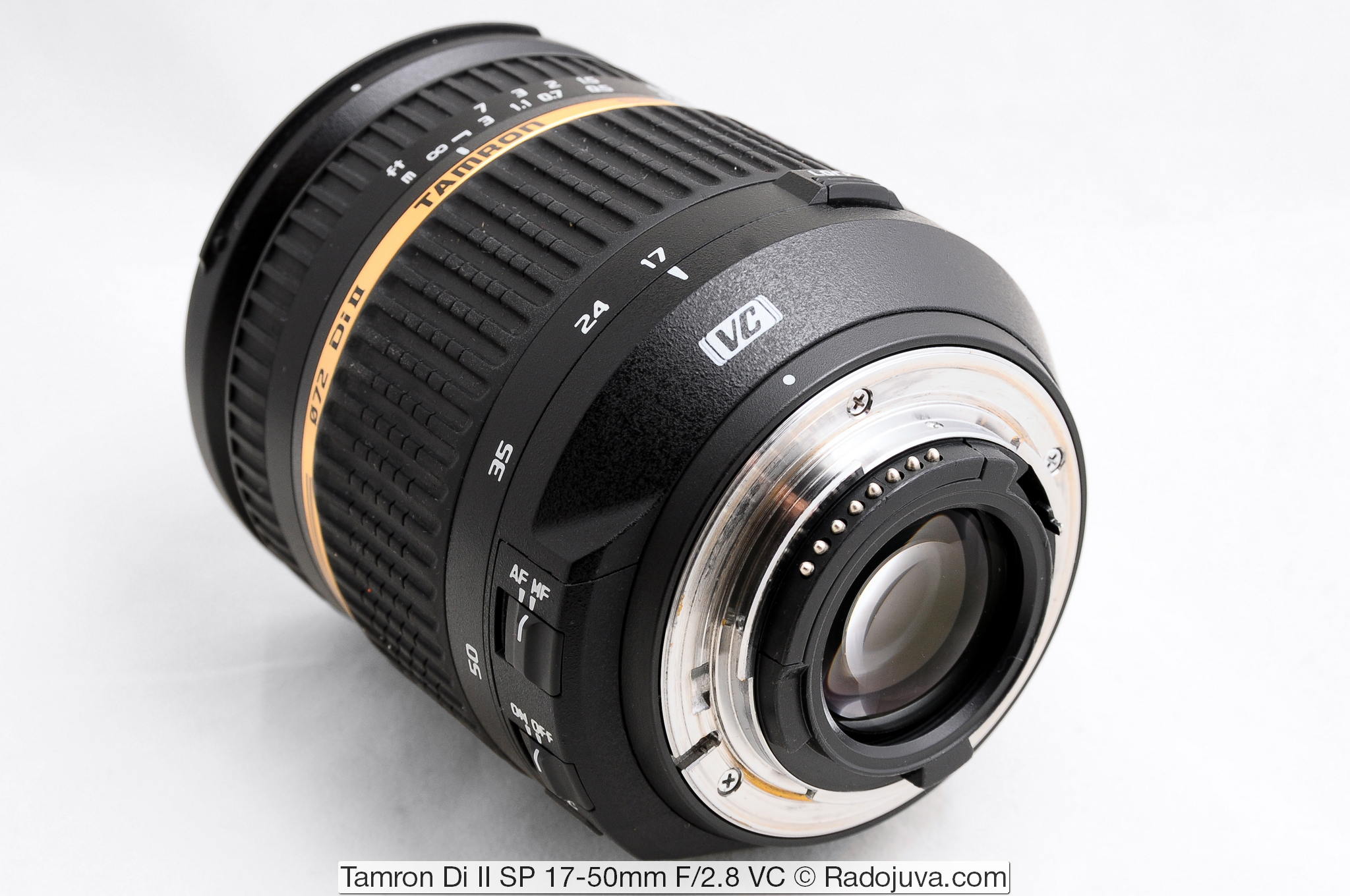

Good time! I've been racking my brains for a week now - the whale 18-55 (nikon3100) flew. Initially, it was planned to take 50 1.8g to it, but now the question arose about zoom, since in an apartment with a small child you don’t really run into a fifty dollars) I’m still thinking what to take 17-50 2.8 or 28-75 2.8 (tamron)
Mostly shooting a child at home, portraits and nature.
How much vc is needed, as I understand it, in 28-75 it is not?
In the arsenal there is still carl zeizz 50 2.8, well, and the kit, in principle, if that works without autofocus and stub)))
VC is desirable, but you can do without it. In 28-75 he is not.
Thank you for quick response.
That is, all the same, as a staffer it is better to consider 17-50?
Yes, 17-50 as a staffer is not bad.
Arkady, in a review of the previous lens without VC, you spoke about its poor build quality, but how is it constructive, more reliable? There is an older version in your arsenal, but did you just test and give this away? And one more thing: did you check the alignment of these lenses. The fact is that I became interested in one old 20-40mm tamron from a friend of the photographer, but thank God I checked the adjustment on the table, on 20mm he showed a big back focus, on 40mm everything is fine, but how are things with these 17-50, I want to replace as a staffer with Nikkor 1.8d 50 mm (perfectly aligned). Does it make sense to change? In general, do you pay attention to the correct alignment of the lenses, they say that this is a problem even for expensive top-end lenses. Sorry to ask so many questions.
I pay attention, but I do not raise it to the rank of problems. The version with a stub was on review for a couple of days, I don't know if it will fall apart like the older version.
Can he focus on the Nikon d5100?
Yes, he can.
scho please for the knowledge of architecture (in the road) on nikon d90 vibira
Sigma AF 10-20mm F4.0-5.6 EX DC HSM is more often required. crazy!
I recommend this shirik - https://radojuva.com.ua/2012/04/obzor-tokina-at-x-124-pro-dx-ii-12-24-f4/
Arkady, such a question. I stopped in choosing a staff on this particular Tamron, very nice pictures from it, reviews, plus your article. In addition, having a fixed fifty-kopeck piece of 1,8D (a very memorable portrait lens!), I will supplement my park with a good high-aperture kit for architecture, landscapes and weddings. I ordered it from the online store. Please tell me how to check it without messing with tables? Because the department of "New mail" is unlikely to endure my fuss for a long time. And I don't want to fly into the back- and front-focus: in Zaporozhye hardly anyone knows how to adjust the lenses. Thanks in advance for your reply!
If the shot with Live View and normal focusing through the optical viewfinder coincide, then there are no back / front focuses.
Thank you very much! Just allow me to clarify. That is, you can try to remove both modes, for example, some remote object and a sheet of paper with text. And compare. As I understand it?
Yes. Live View does not give errors, if the results differ, then in the normal focus mode there may be failures.
Thank you very much! :)
Arkady. Good evening. I choose a standard lens for my d90. now I stopped at this option and 18-200 from nikon ... tell me please, I'm not so interested in versatility as in the quality of the picture ... with which one can I get more colorful, sharp and high-quality pictures?
A number of parameters and nuances are responsible for the color and sharpness of photographs, not only the lens. 17-50 on closed diaphragms will be sharper.
Yesterday I took my Tamron from Novaya Poshta (I found a Japanese one made for the USA and Canada - the online store where I ordered glass and which, according to rumors, is controlled by the Kiev Tax Office, dumps counterfeit goods). At the post office there was no way to properly protest, I did it at home. Arkady, followed your advice: I took pictures through the viewfinder and in LiveView mode. In the first case, back focus was observed on the 17mm lens, closer to 35mm everything fell into place, at 50mm the lens was crystal clear in terms of focusing :). In LiveView, everything turned out smoothly and beautifully at all focal lengths. I shot, as expected, at f2,8. And with a stub, and without it. Arkady, my question is: is this back focus at a wide angle forgiven or is it better to adjust? There is no desire to return, as returning in the online store is too much trouble. And there is no guarantee that "clean" glass will be sent in return. Or still not to regret your nerves and return?
One more thing: with a built-in 17mm flash (photographed in the room), a semi-oval shadow appears at the very bottom of the frame. I turn off the flash - everything is in order, no shadow, with the same FR and under the same conditions :). With a flash, there is no such shadow at 35 mm. Probably because the flash is built-in - some laws of physics apply :). As it is written in your review, there is a famous "barrel" at a wide angle, you can't get it anywhere, so you need to very carefully build the frame so that the impressions from it are not unpleasant :). In general, I liked the lens very much, I just need to get used to it. After fixing it is a bit unusual. But the chromaticity is excellent (someone somewhere complained that it turns yellow - yes, nothing turns yellow, you need to set WB normally and get off the automatic mode), sharp and, in principle, frisky. Of course, the stub is not for scouts: it will give out :) :) :). Although it works very well.
this is your shadow from the lens, if you put an external flash it will not be there. light propagates rectilinearly such laws of physics)
So you write about the choice when buying, but tell me, is there any general recommendations for checking and testing lenses? Thanks!
good evening. Great review and just enjoy reading your reviews every time. please tell me more precisely help with the choice. I have a 50mm 1.4G. I can shoot full-length portraits with them, but I often shoot landscapes and I have a DX camera. remained between the choice of Nikkor 20mm 2.8D and Tamron 17-50 2.8 VC. I know they have different goals, but still, what is better for the landscape? Nikon's build and picture quality will be better, and the tamron is a little more versatile. what would you choose for the landscape from these two or can you recommend something else in this price category, aperture so that it is
Hello!
Very nice site!
Please tell me what is the best choice for crop: TAMRON 17-50 f / 2.8 VC or 50mm f / 1.4G AF-S Nikkor.
I would like to buy a second one, but I’m afraid that I won’t be able to use the fix as a staffing (a too small angle), and if it’s a feather, then suddenly the bokeh will be weak ..
THANK YOU!
Hello!
Very nice site!
Please tell me what is the best choice for crop: TAMRON 17-50 f / 2.8 VC or 50mm f / 1.4G AF-S Nikkor.
I would like to buy a second one, but I’m afraid that I won’t be able to use the fix as a staffing (a too small angle), and if it’s a feather, then suddenly the bokeh will be weak ..
THANK YOU!
In my review there are examples with pronounced bokeh, see.
Hello! Tell me how this lens will work on the nikon D3100 camera and is it worth it? Thanks for the answer!
Yes, it will.
Hello, Arkady. I purchased nikon d80 and this tamron. I’m learning to take pictures (for myself, most likely), I’m taking pictures of everything, a home feast, a view from the mountain, the mountain itself, trees, people on the street, and so on. The question is: is the lens too good and cool for such an old carcass and for such an amateur?
Unusual question. It’s a normal kit, it’s good when the lens is cooler than the camera :)
on the "cloudy eye", you can't pull the Leica)))))
Hello, Arkady.
Bought a Nikon D700 body. For the second week I can not decide on the lens. At the moment, I choose between:
- Sigma AF 17-50mm f2.8 EX DC OS HSM (4900 UAH)
- Tamron SP AF 17-50mm F / 2.8 XR Di II VC LD Aspherical (IF) (4200 UAH)
- Nikon AF-S DX VR Nikkor 16-85mm f / 3.5-5.6G (4200UAH)
Mostly shooting a child at home with the SB-600, portraits and nature.
Please help me make the final, right choice in purchasing a lens.
Perhaps you will advise some other option, the budget is up to 5000 UAH.
Thank you very much in advance!
corrector, Nikon D7000
In the near future I also plan to purchase Nikon AF-S DX Nikkor 35mm f / 1.8G
Can see here http://www.the-digital-picture.com/Reviews/Sigma-17-50mm-f-2.8-EX-DC-OS-HSM-Lens-Review.aspx and a question and where are the sigma wielders for 4900 gr ??? I want it already
D5100 camera and Nikon 50 g!
Question: I want to shoot weddings and there are 25 =!
What a second lens to buy based on my budget!
Thank you Arkady for your thoughts!
I study on your site !!!
At least this Tamron.
I realized that this tamron is good, but I would like the best or the tamron is the best in its price category !?
And what about Nikon 28 F1,8 in conjunction with my 50 F 1,8G, what do you say?
28 1.8 is good, but the breadth of the angle will suffer.
But what if you take a loan for the D7000 and Nikon 24-70mm f / 2.8G ???
And go to the wedding!
Arkady many thanks to YOU for your work so necessary for us! I ask you for help ... I am choosing the first DSLR. After long and painful torment, I think about Nikon d 5100. (though I was sure for a long time that Nikon d 7000 is better - but the price also plays a role, half as much by 5100 and I think it is better to buy a better quality lens from a whale for the "freed up" money I also want it partly because of financial considerations (but! maybe I'm wrong.) And here again a vital question arose))) Help with the choice. Choose from: Tamron SP AF17-50mm F / 2.8 XR Di II LD Aspherical (IF) for Nikon, Sigma 17-70mm F2.8-4.0 DC Macro OS HSM for Nikon, Nikon AF-S NIKKOR 50 mm f / 1,8G , Nikon 18-105mm f / 3.5-5.6G ED VR AF-S DX Nikkor, Nikon 16-85mm f / 3.5-5.6G ED VR (5.3x) AF-S DX Nikkor. One of the service centers advised sigma 17- 50 2.8ex os hsm. Which of this will you advise me or maybe something else? Thank you in advance for your answer and in general for the opportunity to ask questions.
As a fast / portable / creative one - Nikon AF-S NIKKOR 50 mm f / 1,8G, as a 17-50 2.8 wagon, or Sigma or Tamron, if you find good ones.
Thanks a lot!!!
Arkady good day, tell me please the main criterion for buying a used d7000 and whether it is worth it.
The criteria should be determined by you, I don’t know what the camera is for.
Tell me, will it be a worthy replacement for whale 18-105, with the same shooting parameters, will the picture noticeably differ from them? Thank you.
It will be 100% better picture but it has 17-55 and you have 18-105
I accidentally stumbled upon your site, in my opinion, it is the best in terms of photo equipment on the network. I have this problem, I have a rather old, but working Canon EOS 30 D with a standard lens 18-55. I don’t like that the pictures are not obtained very sharp and somehow blurred. A friend advises you to buy Nikon 5100 with a regular lens 18-105. And if you leave your Canon and buy this lens for it, is it noticeable to improve the quality of the photo. And does it make sense to buy a new camera? Thank you in advance for answer. I photograph exclusively nature in travels and memorabilia iki.
We need to try, in principle, the picture should become sharper, Tamron is a more modern lens with a higher resolution
buy Canon EF-S 18-135mm f / 3.5-5.6 STM IS, it is sharp on all focal and apertures, the price is up to 1000g. (I saw in the digital store, do not count for advertising)
Arkady, please answer, will you have a Sigma AF 17-50mm F2.8 EX DC OS HSM review in the near future?